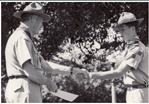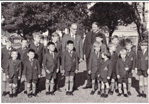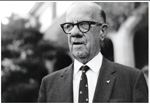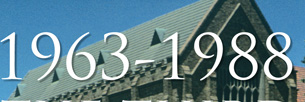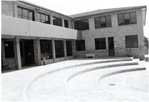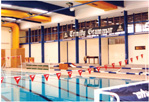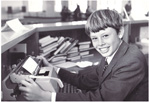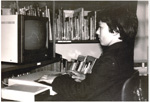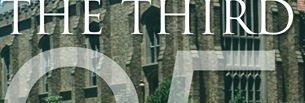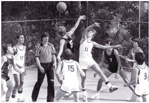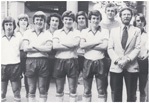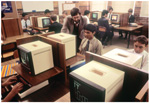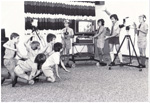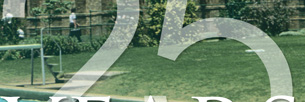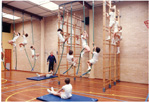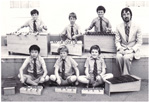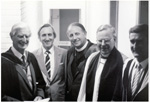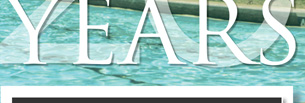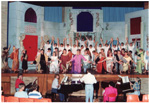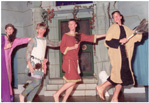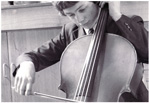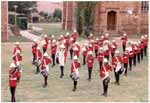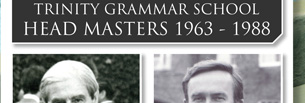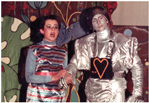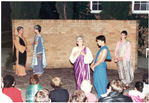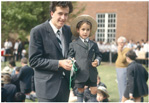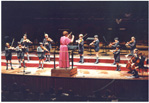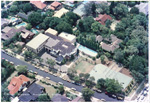
A MODERN EDUCATION
From 1963-1988 – the third quarter of Trinity’s life – the shape of education in NSW changed. The early 20th Century model was transformed into what is much more recognisable as a modern Trinity education in its breadth, subject scope, vibrant arts and music programme, variety of co-curricular activities and sports, and an embracing of new technology.
The Head Master – Mr Hogg – continued to lead the School in the 1960s through the implementation of what became known as the Wyndham Scheme. This major review of the conduct of education in NSW by a committee of ten men, including Bishop W G Hilliard, which was chaired by H S Wyndham, produced eight major recommendations. Amongst other things they reorganised the secondary school curriculum into a structure of Core subjects with additional Electives, and extended secondary schooling to a possible six years – four compulsory years for all students ending with the School Certificate and two further years followed by the Higher School Certificate for those wishing to continue to university. The old Intermediate and Leaving Certificates were abolished and the first HSC exams took place in 1968.
CURRICULUM AND CLASSROOMS
The new Core curriculum included English, Social Studies, Science, Maths, Music, Art, Crafts, Physical and Health Education, and Religious Education, and implementing this, together with catering for the additional year of secondary school, required additional School staff and classrooms.
At Summer Hill this meant that the new Science Building needed extension – completed in 1966 – and a new Arts, Crafts and Music Centre was also necessary. This Centre was opened in 1969 by the Head Master’s wife – Mrs Alyson Hogg – in recognition of her special interest in the Arts.
The Society of the Arts flourished in this era, and the first Trinity Festival of the Arts took place in 1965. A grand old house across the road from No 3 Oval, purchased by the School from Mrs Delmar, was the location of the first Delmar Art Exhibition in 1967, which showed works by Trinity students. The initiation by the Trinity Society of the Arts of the School’s own art collection in 1966 culminated in the construction of the purpose-built Delmar Gallery which opened in November 1988.
PREPARATORY PROVISIONS
The Preparatory School also underwent a rejuvenation of facilities and population in this quarter century under the leadership Rev K L Sandars (Master of the Prep School 1965-1986).
The old Junior House (Lauriston) site was sold, and the remaining Junior Boarders moved to Summer Hill. This enabled the purchase of Milverton, almost next door to the main Prep site of Llandilo, which was officially opened as the Sub-Primary School in February 1968. The Prep magazine ‘TP’ was first issued that same year and continued for twenty more.
Prep facilities were further extended with the construction of a Cub Den (1969), Library additions (1969), a New Wing and Chapel Annex (1970), a Creative Activity Resource and Teaching Centre (1975), a Community and Physical Education Centre (1982), and a New Music Complex and further Library extensions (1984). Making use of these facilities was a growing pupil body expanding from 329 pupils in 1963 to 529 in 1988.
“OLD KASPAR’S WORK WAS DONE”
Mr Clarrie ‘Kaspar’ Latham concluded his career at Trinity at the end of 1970, retiring aged 78 after more than 53 years at the School, 21 of these being as Senior Master. He had taught generations of Trinitarians.
THE WIDER SCENE
The 1960s was the decade of the State Aid Debate – an at times vociferous argument about the Federal Government policy on the allocation of public funding for independent schools, and the method by which the allocation was calculated.
Decimalisation took place in Australia in 1966, and in 1969 Australians watched on their televisions the landing of the first man on the moon. The reintroduction of National Service, conscription and the Vietnam War (1962-1975) – in which two Old Trinitarians perished – provided another backdrop to the era. The Constitutional Crisis and the sacking of Prime Minister Whitlam in 1975 was another momentous event.
Following Mr R I West’s appointment as Head Master in 1975, the School’s expansion progressed in a variety of ways. The House System was greatly expanded – from four to twelve houses – to more adequately provide for the pastoral needs of the pupils. In 1979 pupil numbers were decisively expanded with the Year 7 intake reaching 170. As these boys progressed through the grades, the School Council planned for the secondary school to reach an enrolment of 950. Additional staff and facilities were necessary to cater for this growth. The New School classrooms and the Latham Theatre were opened in 1982, the Administration Building in 1984, and an indoor swimming pool in 1985.
Other innovations of this quarter century included some new sports gaining a place at Trinity. Basketball was introduced in 1968, followed by Soccer (Football) (1975), Volleyball (1985) and Water Polo (1986). Co-curricular activities along with Saturday sport became compulsory for secondary pupils and an annual Activities Week was added to the school calendar.
Drama thrived at Trinity in this era in the Middle and Senior Dramatic Societies. The opening of the James Wilson Hogg Assembly Hall with seating for 1100 on the eve of Mr Hogg’s retirement in September 1974, provided a venue suitable for larger productions and musicals, and was supplemented by other new performance spaces – the Greek Theatre and the Latham Theatre.
One unusual innovation of the 1970s were the community singing sessions which took place while the majority of staff attended the Head Master’s briefing in the period before recess – Messrs Ogier, Parker and Littlejohn succeeded in coaxing several hundred teenage boys to sing with gusto!
TECHNOLOGY
In 1963 television broadcasting in Australia was less than ten years old, but technology for the classroom was not far away. As early as 1972, a Computer Club was begun at Trinity by Mr S O’Brien. Personal computers were being developed in the USA, and the Apple II computer was launched in 1977 followed by the IBM–PC in 1981, and the Macintosh in 1984.
The acquisition of an Apple II Micro Processor with a memory capacity of 48,000 characters was newsworthy when acquired by Trinity in 1979. Computer labs were installed at Trinity for both the Secondary and Prep School lessons in 1983 under the guidance of Mr R Abbey. The BBC Micro was used for language teaching and in 1986 the Apple Mac reached the classrooms and a Wang Computer was purchased for use by the administration staff.
The School Council reported in 1985 that Trinity was “believed to be the School leader in Australia in Computer Education”.
The Triangle of 1980 published articles by pupils on the topic ‘What effect will computers have on my life?’ The ideas were mixed:
“Most professions will have most of their staff superseded by a computer, I will probably become a full time recreationist.”
“If this computer ‘take-over’ of jobs that are normally filled by people occurs, then when it happens it will be very difficult to find employment.”
One student concluded “It is hard to imagine what computers will be built to do in the future, but one thing can be said for certain, and that is they will make our lives easier.”
75TH ANNIVERSARY
1988 was a year of celebration as the nation marked the Bicentenary, and the whole School gathered for a 75th Birthday Party. Services of thanksgiving and commemoration were also held at St Andrew’s Cathedral and Holy Trinity, Dulwich Hill. Reunions of former staff and students included some who had been at the School in its earliest years. Music featured large and a Gala Concert at the Sydney Opera House celebrated the talents of the School community. The staff performed the musical ‘Oliver’ for the pupils’ entertainment, and a 75th Anniversary Invitation Music Festival was convened with a number of other junior school choirs joining the boys from the Prep to perform. Perhaps the most lively event was when the assembly hall reverberated to the beat of the band ‘The Cockroaches’.
While this quarter century was a period of both social and technological change, it also had, at Trinity, an element of stability. Having just two long-serving Head Masters (together they spanned half a century at Trinity) meant the School was able to grow and develop in ways that were impossible in its earlier years.
THE THIRD 25 YEARS
- 1913 - 5 staff and 57 pupils
- 1939 - 12 staff and 196 pupils
- 1962 - 54 teaching staff and 995 pupils
- 1988 - 115 teaching staff and 1507 pupils
- In the third 25 years, another 4950 pupils passed through the classrooms of Trinity - almost double that of the previous quarter century.
- By 1988 there were just over 9000 Old Trinitarians
Source: The School Archives

